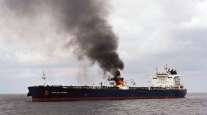Bloomberg News
Storms From Texas to China Set to Worsen Global Ship Snarls

[Stay on top of transportation news: Get TTNews in your inbox.]
Global supply chains already tangled by the pandemic, labor shortages and sustained consumer demand in the U.S. are getting walloped by another disruptive force: Mother Nature.
Typhoon Chanthu is expected to hover near the mouth of China’s Yangtze River through Sept. 15, temporarily shutting operations at major ports. In Texas, the heart of the U.S.’s energy and chemical industries, Tropical Storm Nicholas made landfall overnight, forcing terminals in Houston to curb cargo handling and restrict vessel traffic little more than two weeks after Hurricane Ida barreled into neighboring Louisiana.
Even temporary delays around two major trade gateways will ripple across a global shipping industry that’s running with little slack during one of the peak seasons for ocean freight.
“The timing is awful and will add more pressure to an already stricken supply chain, particularly given the size of these ports,” said Simon Heaney, senior manager of container research at Drewry Shipping Consultants Ltd. “Every COVID-19 case and extreme weather situation compounds the problem and delays the return to normal operations.”

Shipping containers on the dockside at Tianjin Port in Tianjin, China. (Gilles Sabrie/Bloomberg)
Emblematic of the bottlenecks in trans-Pacific commerce: The queue of container ships waiting to enter the twin ports of Los Angeles and Long Beach, Calif., rose to a record 56 vessels as of Sept. 13.
Colin Song, general manager with Dongguan, China-based World-Beater International Logistics Co., said it usually takes about two weeks to ship from most Chinese ports to Los Angeles, but now the journey takes more than two months. “Typhoons will definitely make the situation even worse,” Song said.
In the Gulf of Mexico, oil and gas production is still recovering from Ida’s destruction, which also shut down grain shipments along the Mississippi River. Texas is also a major crossroads for chemical makers — many of which were forced to close during winter storms in February that led to shortages of industrial ingredients.
LIVE in Beaumont, Texas, @JMichaelsNews shows flooding from #Nicholas.
As this storm continues its trek along the Gulf Coast, stay inside and stay off the roads if you can! pic.twitter.com/aZJ3lczO1N — The Weather Channel (@weatherchannel) September 14, 2021
Nicholas, which was downgraded to a tropical storm after briefly being rated a hurricane, roared ashore on Sept. 14 near the Matagorda Peninsula southwest of Houston. Flash-flood warnings were expected across the South.
“The recent hurricane season is exacerbating disruptions to port operations already crippled by the pandemic, and really stretching global supply chains to the limits,” said Serena Huang, a senior analyst with Vortexa Ltd. “These supply chain disruptions are really posing a major challenge in moving commodities to their destination markets.”
Operations at major wharfs at the province’s Zhoushan port — home to some of China’s largest oil storage tanks and refineries — have been halted since the afternoon of Sept. 11. Chinese container ports affected by the latest storm were scrambling to reopen at least partially on Sept. 14.
China’s port congestion “will likely lead to more shipping delays and canceled sailings, which could in turn send shipping rates, especially for container freight, to new record highs yet again,” said James Teo, a transportation analyst with Bloomberg Intelligence in Singapore.
Still, it’s not clear how much higher container rates can go even with capacity getting tighter. Two major carriers, France’s CMA CGM SA and Germany’s Hapag-Lloyd AG, said in recent days that they’re capping spot prices pushed to record highs by earlier disruptions. The other major liner companies haven’t publicly disclosed their pricing plans.
Want more news? Listen to today's daily briefing below or go here for more info:




